Digital Economy Growth
Technology has become an integral part of our daily life. Communication, ordering food, traveling, entertainment – we can do it all through a smartphone with an internet connection.
Mobile banking and e-wallet applications have become commonplace for everyone. By April 2022, non-cash payment transactions increased by 69.7% in quantity and 27.5% in value. Currently, 66% of adults have mobile banking accounts and e-wallet accounts. The CAGR of accounts is 11.44% from 2015 to 2021.
Vietnam has a golden population structure where 52.7% of the population’s age is between 15 and 49 (GSO, 2019). This group will lead the future of digital consumption and technology because of their ability to access the latest technology and fluently use the hi-tech devices and apps from new technology. The group is a driving force for the future development of the digital economy.
The digital economy is expected to reach 20% of GDP by 2025F and 30% of GDP by 2030F. To achieve this scale, the 5-year average growth of the digital economy must reach 40% annually from 2021 to 2025F and 19% annually from 2025 to 2030.
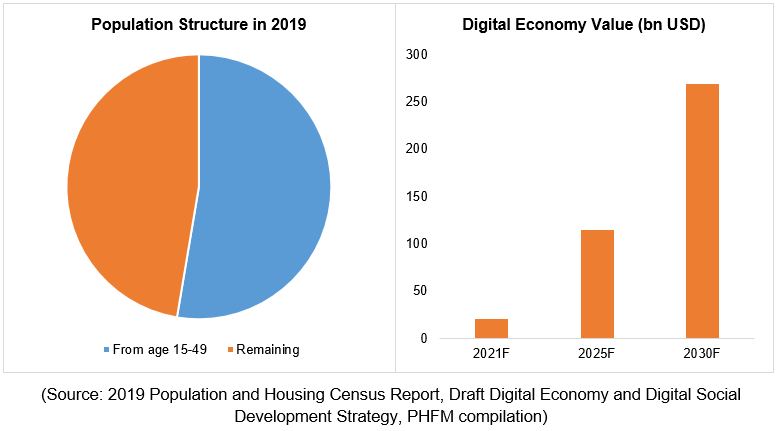
The digital economy has three components: (1) ICT digital economy; (2) Internet digital economy or Platform digital economy; and (3) Sectoral digital economy. Specifically, the ICT digital economy includes hardware production, software, digital content, IT services, telecommunication, and Internet access. Internet digital economy includes digital data, digital platform, digital services, digital business, sharing economy, algorithmic economy, the Internet economy, and Gig economy. The digital economy includes e-management, e-commerce, e-banking, smart manufacturing, smart agriculture, and smart tourism.
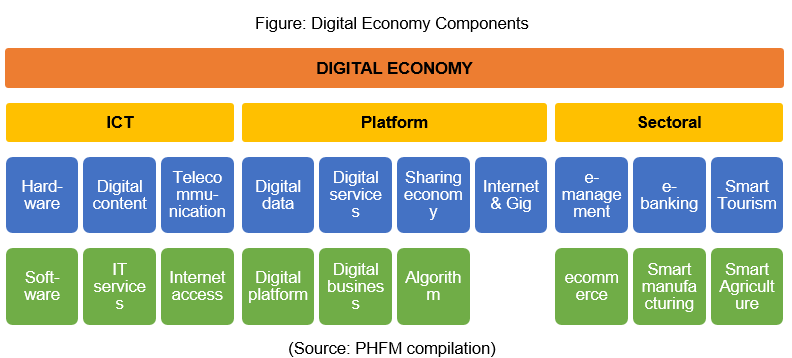
Per the estimation of MIC (Ministry of Information and Communications), the digital economy’s revenue in 1Q22 reached USD 53 billion. The platform’s digital economy has a growth of 28%, reaching USD 8 billion in revenue. The remaining USD 45 billion belonged to ICT and the sectoral digital economy, with a growth of 15%.
Digitalization Is A Way
In 2021, Vietnam faced a pandemic on a large scale, which led to the digitalization transformation (DX) process faster. Due to the Covid-19, social distancing requires businesses and organizations to adapt to maintain operations. DX was the best solution at that time.
DX is a key driver for growth and recovery in the post-pandemic period. According to the World Bank Report, DX brings many great benefits and advantages to businesses and organizations. Firstly, CX provides a lot of supporting information for businesses and organizations in analyzing, having many sales opportunities, and improving business efficiency. Secondly, DX makes processes smoother and saves more time. Thirdly, the organizations will save costs and increase their market competitiveness from efficiency and time-saving benefit. In addition, based on useful information, businesses can develop new products to meet customer needs, and the government can understand the people better.
Retail is an industry that witnessed many changes when implementing DX. DX has rapidly changed customers’ consumption habits and shopping behavior in the industry. After the Covid pandemic, the online channel has become the main shopping channel of customers instead of other traditional channels such as markets, supermarkets, and grocery stores. Businesses are also promoting digitalization to reach more customers. The percentage of businesses that receive sales orders through e-commerce has witnessed a high growth rate.
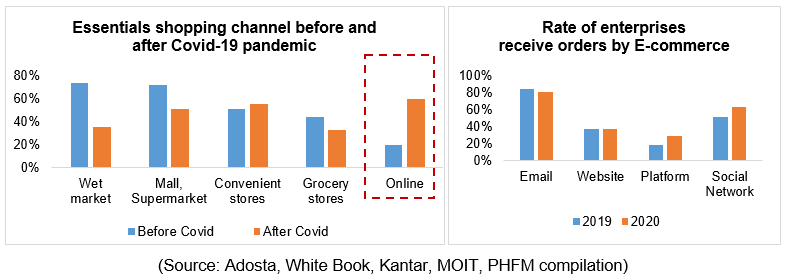
The modern retail channel is expected to “overtake” the traditional retail channel in the future. Specifically, the proportion of modern retail channels may account for 50% by 2025 and 60% by 2030.
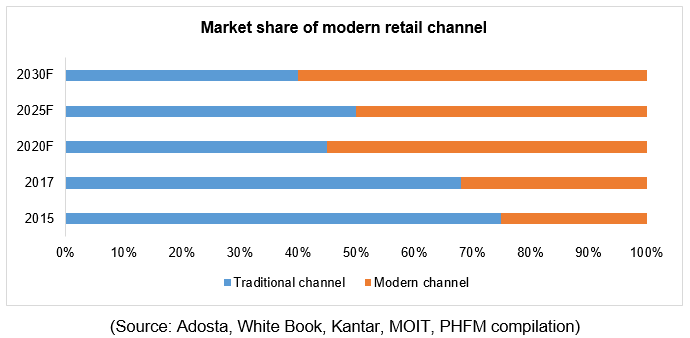
Tailwinds for Companies in the Industry
The Government supports the DX for all aspects of life. At The National Forum for Digital Business Development in Hanoi on 11 December 2021, the Prime Minister stated that DX would be a driver for the economic recovery and development in the post-pandemic period. According to Decision 50/NQ-CP dated 20 May 2021, the Government mentioned that DX would be the key focus from 2021 to 2025. DX for SMEs will be focused on the period.
Vietnam has shown its determination to implement DX for the Government, economy, and society in the upcoming years. There are three main goals. They are (1) speeding up the DX progress, (2) raising people’s awareness in society, and (3) promoting the participation of all sectors in society.
Vietnam has a certain advantage in implementing the DX nationwide. Vietnam has a relatively low cost of Internet access compared to other countries globally and is about 46% lower than Thailand. Fast and affordable internet is the backbone of the DX.
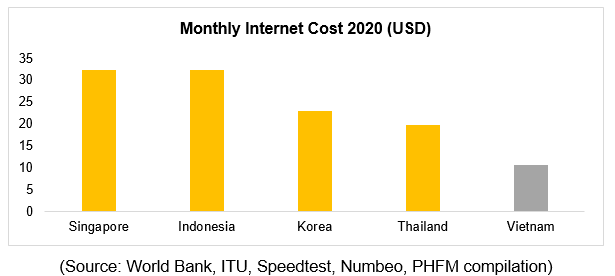
However, Vietnam has some obstacles that need to be overcome when DX is universalized. Firstly, Vietnam needs to expand its internet coverage nationwide. At the end of 1Q22, only 69% of Vietnamese households have broadband access. Currently, there are 980 wards without broadband access in Vietnam, of which 774 wards will be covered by telecommunication companies before 30 June 2022. Secondly, Vietnam’s internet speed is still not high. The broadband speed of Vietnam in 1Q22 improved compared to the prior year, particularly 33.9 Mbps in the download speed of the mobile broadband and 67.96 Mbps in the speed of the fixed broadband, increased by 26% and 44% respectively. However, compared to the other number of over 100 Mpbs of the fixed broadband in Singapore and Thailand, Vietnam still has a huge gap. Currently, about 71% of the adult population has smartphones, and 85% of the households have a smartphone. Hi-tech devices need to be more affordable for people and households.
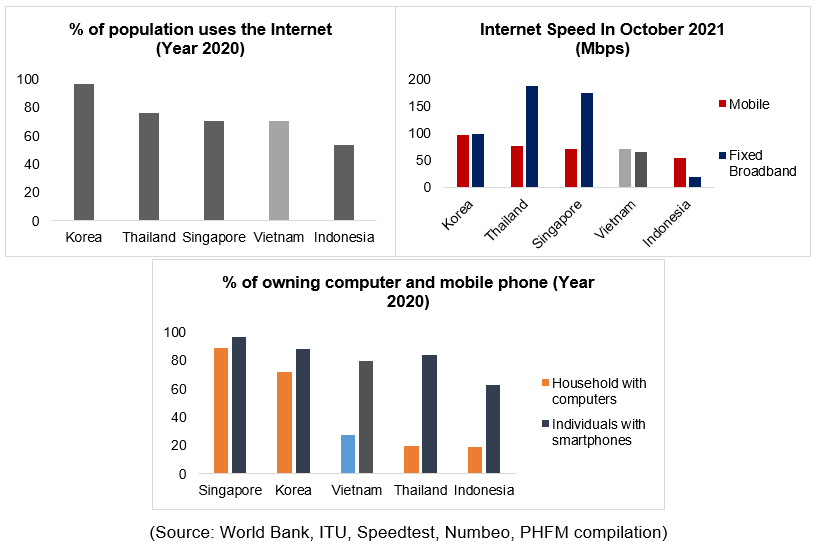
Combined with the encouragement for development from the policy, the obstacles discussed become tailwinds for companies in the technology and telecommunication industry. Companies in the telecommunication and IT infrastructure development sector will have remarkable growth in the future. Companies in the Internet services sector will also have a stable growth every year when the Internet is widely covered and become an integral part of life. Finally, companies in the ICT products trading sector will also benefit when the demand in the future grows because of the need for synchronization between the infrastructure and devices.
